NOTE: My thanks to the guys for their contributions this week, as I just couldn’t get anything finished in time.
Similarly, the month of June is looking pretty hectic, and it feels like it’s time for the Thor crew to take a breather. At this point, the plan is for the column to return in July, hopefully with batteries appropriately recharged.
Star Wars: Rebel Heist #1-2 (Dark Horse, $2.99)
By Graig Kent
It’s an interesting time to be a Star Wars fan these days. Long after the prequels have wrapped and having their confidence shook by The Creator, the lapsed followers are showing renewed interest, and while the devoted may have some complaints, they don’t shake or waiver in their fandom. And why should they? For 20 years, they world has seen a gushing flood of comics from Dark Horse, books from Bantam and video games of all kinds expanding the Star Wars universe to include long, long, long ago and also not-so-long ago stories taking place well before any of the films, and some decades after. The source films are constantly being mined for new material, having most notably spawned a cartoon series that has in some ways validated the existence of the prequels.
I am one of those lapsed fans, which is a curious statement, given that I seem to be in the minority of prequel apologists (another curious statement!). My abandoned fandom came as a result of simple overexposure and fatigue. I couldn’t keep up with the toy, paraphernalia, comic, novel and game onslaught and my appreciation of the Clone Wars cartoon for the longest time didn’t extend beyond the Genndy Tartakovsky-produced series of shorts. I haven’t read a Star Wars comic in a long time… a long time. I have a full long box of Dark Horse Star Wars comics out in my shed but I’d be surprised if any of them were published past the year 2000. At a certain point it just became too big a strain on the pocket book, but also, my level of mental investment was waning. Making sense of hundreds of years of in-story continuity seemed like a full time gig as a fan.
Star Wars: Rebel Heist wasn’t the first Star Wars item to tempt me back into the fold. I did get sucked into a run through of Star Wars Angry Birds, Star Wars Pinball has been fairly satisfying as well, and I’ve also just started catching up on Clone Wars on Netflix last week with my 4-year-old (who loves Jar Jar Binks… I try not to visibly express disappointment). As far as comics are concerned, however, despite being curious about Brian Wood’s Star Wars or the “The Star Wars” first draft adaptation, I haven’t actually bit on laying down cash for any of them. What made Rebel Heist different?
Not “what”, “who”: Matt Kindt.
Kindt is one of those creators whose output is interesting and different enough that it’ll always draw my attention. His creator owned work, like Super Spy or MIND MGMT is nothing shy of brilliant, while his mainstream output will regularly toy with conventional storytelling. I won’t necessarily read everything he’s writing (I’ve withdrawn myself completely from the Valiant Universe due to constraints of budget and time, and Kindt’s work there seems to be very much Universe-building in scope) but his name will definitely give me pause for consideration.
With Rebel Heist he’s once again playing with the conventions of the characters, their universe, and the storytelling mold they typically fall into. Set between Episodes IV and V, the stories of this series find fresh eyes viewing the heroes of the Rebellion. In the first issue, a young rogue is looking to enlist in the Rebellion, and comes to find his contact point is no less than infamous smuggler-turned-hero Han Solo. As they navigate their way through a gauntlet of Imperial agents, Han imparts his sage pirate wisdom (observations on the enemy, tips about the Rebellion, old rogue tactics) on the new kid, while the kid tries desperately to ease into both his awe of Solo, and the decision that has thrust him into a hail of blaster fire. Things surprisingly don’t go well for the duo which, oddly, is part of the plan.
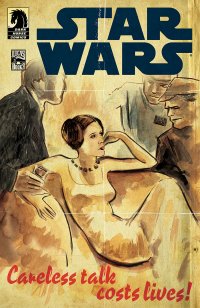 Issue two introduces us to a Twi’lek agent of the Rebellion and a side of the Star Wars universe we (or at least those of us who are lapsed Star Wars fans of a decade or more) don’t see much of, with Kindt calling upon his Super Spy background to deliver an espionage tale. The Twi’lek heads to the rendezvous point for her next mission, an infiltration job, to find that she’s acting as back-up to…a princess? At first, finding out that Leia is going to be performing the mission is not only disappointing but also has her nervous about its potential success. But quickly Leia’s bold personality and relative fearlessness assert themselves and the Twi’lek, like the rogue in the previous issue, is impressed. The hype doesn’t even measure up to the reality.
Issue two introduces us to a Twi’lek agent of the Rebellion and a side of the Star Wars universe we (or at least those of us who are lapsed Star Wars fans of a decade or more) don’t see much of, with Kindt calling upon his Super Spy background to deliver an espionage tale. The Twi’lek heads to the rendezvous point for her next mission, an infiltration job, to find that she’s acting as back-up to…a princess? At first, finding out that Leia is going to be performing the mission is not only disappointing but also has her nervous about its potential success. But quickly Leia’s bold personality and relative fearlessness assert themselves and the Twi’lek, like the rogue in the previous issue, is impressed. The hype doesn’t even measure up to the reality.
The two stories loosely connect, with the second ever so slightly building upon the first, and setting the path to the third, in which another less-notable character in the Star Wars universe encounters one of its brightest heroes, Chewbacca. It’s an intriguing way to tell a story, with the issues paralleling each other, hitting similar rhythms, themes and conclusions but also moving a bigger picture onward. They’re action heavy, but also narrative heavy, as the lesser characters observe these champions of space in battle, so there’s multiple layers of engagement. Artist Marco Castiello does a phenomenal job with the movement of the action, largely keeping the characters on-model with elaborate settings that feel alien but familiar to the Star Wars universe. Some of the background wardrobes are, perhaps, a little bland, and at times the Castiello’s inking gets muddy, making details less refined, but overall I like his work, like a young Duncan Fegredo.
As for the stories, they’re solid. They’re not overly great, and in particular, thrusting Leia into the role as super-spy seems incongruous to the character as I know her, but the reinforcement of these characters as legends on the Rebellion’s ground floor after blowing up the Death Star is something that’s not been much explored. Equally, having a look at the grittier side of the Rebellion, the quiet battles that take place by undercover agents or the struggle to get recruited, these are equally less common terrain (largely because they pull Star Wars down in to a reality that’s less attractive than the big picture spectacles).
Down the pipe we have at least six new films on the roster, a new cartoon series bridging the gap between episodes III and IV and, in a less positive light, the end of the expanded universe. In comic book terms, Star Wars is going New 52 on us, dispensing with anything that isn’t the films (does that include The Clone Wars, I wonder) and rebooting the future (and the past) of the galaxy far, far away. Does it make a difference to the stories that remain to be told? I don’t think so, or, at least, not yet. Rebel Heist may not remain canon for long, but it exposes the main characters in an unconventional light that’s going to interest longtime fans.
Rating: 




Out of a Possible 5 Stars
Interesting Drug GN (Archaia, $29.95)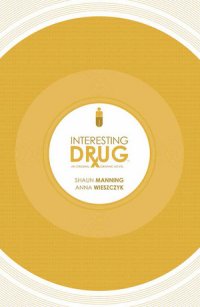
By Cat Taylor
If Christopher Nolan was a comic book writer, and wasn’t working on Batman, I suspect Interesting Drug is the kind of comic book he would write. It’s rare to find a science fiction story in movies or comics that successfully hooks the reader with a puzzle at the beginning and brings it to a satisfying conclusion. However, Interesting Drug does exactly that. Writer Shaun Manning introduces Andrew, the protagonist, as a college dropout slacker with so little ambition that his girlfriend dumped him over it. Things change quickly when he meets Tristram, a stranger who claims to have travelled from the future with the help of a drug that he and Andrew would develop together. Although the claim seems absurd, Andrew is drawn into investigating and soon develops a drug that doesn’t actually let the user travel through time but allows him to relive certain experiences from his or her past. Of course, this begs the question of how Tristram could be from the future if the drug is only a nostalgia drug. Andrew wants to get to the bottom of several suspicious things about Tristram but he also becomes obsessed with improving the drug to let the user actually alter the past. To explain more than that would be getting into spoiler territory, but without some synopsis I suspect most readers would overlook this book. After all, the cover image doesn’t give any clues as to the content, the price is high for an unknown product, and if the title is intriguing to a reader then that reader must be a fan of Morrissey. I’m not sure whether I respect such a subtle marketing approach or if I want to kick Manning and Arachaia in the ass for not doing more to let readers know what kind of gem they’ve got here.
In addition, the simple cover image hides the fact that Anna Wieszczyk has included a variety of stylistic choices for her interior art. She does so with a subtlety that doesn’t get into artsy-fartsy territory but rather sticks mostly with a basic linear style that combines standard American and manga sequential comic art. Therefore, the characters remain identifiable and consistent but she exercises her creativity with watercolor washes and collages of drawing and photography. I noticed that in most, if not all, scenes of traffic, she uses actual photographs of cars rather than drawing them. As a person who has difficulty drawing vehicles myself, I have to wonder if she suffers the same artistic “handicap.”
If I haven’t sold you on the book so far, let me say that Interesting Drug reminds me more of a movie than a comic book story. One reason is because it’s a stand-alone graphic novel, but plot and progression-wise I was reminded of Memento, Triangle, Primer, Time Crimes, Inception, Looper, etc. more than any comic book I’ve read. So, if you’re looking for a little challenge rather than this week’s superhero battle, then you could do a lot worse than Interesting Drug.
Rating: 




Out of a Possible 5 Stars
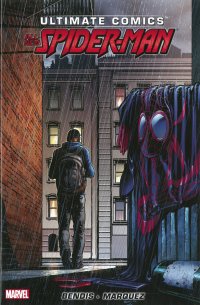 Adam X. Smith presents… Waiting For the Trades
Adam X. Smith presents… Waiting For the Trades
Ultimate Comics: Spider-Man Volume #5 HC (Marvel, $24.99)
The True Lives of the Fabulous Killjoys TPB (Dark Horse, $19.99)
By Adam X. Smith
Look alive, sunshine…
Sometimes, like with regular books, people don’t pick up a comic until it’s already been out a while. Sometimes it’s a book that gets a recommendation from a friend or from a review when it comes out in wide paperback release. Sometimes it’ll be a series that has a loyal following but has a slightly frustrating release schedule; other times, the writing and art style of the series just works better in the form of a collected edition rather than as discreet monthly serialisation.
We in what can perhaps laughably be called “the industry” call this “waiting for the trades”.
No we don’t – sorry, that was a complete lie. Maybe it’ll catch on if I say it often enough.
Anyway…
Considering that I’ve stated on more than one occasion that I actually prefer the current run on Ultimate Comics: Spider-Man over his mainstream/616 universe counterpart, I kind of feel like I have to justify the fact that I’m not currently collecting any issues of his flagship series. The fact is, unlike most of the books I read, I always prefer to wait to read the exploits of the Ultimate Universe incarnation of Spider-Man until the trade paperbacks and hardcover come out for two reasons: firstly, when I originally started reading them, I was already some two and a half volumes behind and needed the chance to catch up; secondly, any attempt I’ve made to jump the queue (such as when I read issue #19 and Cataclysm Ultimate Spider-Man #1: Revenge of the Long-Ass Subtitle) has only resulted in me being thrown off by the story’s refusal to meet me halfway for jumping in. Equally, however, this leads to spending ages waiting during prolonged gaps between trades that seem to take forever, for which the only consolation is the short, sharp shock of a binge reading, in what has come to be known as Netflix Syndrome. Hence the title of today’s column.
So anyway, moving right along…
Volume 5 of Ultimate Comics: Spider-Man collects the “No More” arc, and begins one year after the events of “Venom War”, in which Miles Morales’ mother is accidentally killed by a policeman’s stray bullet and his father is seriously injured by the latest incarnation of Venom, resulting in Miles quitting superheroics quite possibly for good (well obviously not, or there wouldn’t be anything to review, would there?). Now, a year later, he has hit his growth spurt, is dating Kate Bishop (no, not that one – not yet, at least) and is trying to build a future with his widowed and increasingly beardy father, all the while being pressured by his best friend Ganke, SHIELD agent and friendly neighbourhood Spider-Woman Jessica Drew and a very pissed-off Gwen Stacy to be Spider-Man again. He refuses to accept the call at first, but when he and his father are caught in the crossfire between a newly arrived Bombshell and Cloak and Dagger, and a revelation from Jessica regarding her own mysterious origin is forthcoming, it becomes clear that he won’t be able to stay out of the costume forever.
The thing that keeps me coming back for more with this series, in addition to the great writing by Brian Michael Bendis and art from the likes of current artist David Marquez and series co-creator Sarah Pichelli, is that it delivers the usual soapy character arcs one has come to expect with Spider-Man titles whilst still making it feel fresh and original in spite of how easy it would be to just phone it in. Let’s face it – pretty much every other alternate Spider-Man is in some way related directly to Peter Parker, whether by blood relation or association. The thing that makes Miles the perfect replacement Spider-Man is that his arc feels like it’s his own – while there are nods to the classic villains and storylines (with this one particularly leaning rather heavily on “Spider-Man No More” but with a more melodramatic bent) it never feels like the series is treading old ground for the sake of it.
Miles shares Peter Parker’s accidental origin, but in every other sense he’s a completely different hero: he still had both his parents alive (until he didn’t) and the source of much of his early reluctance is that he fears being ostracized by his anti-mutant/superhero father; while he doesn’t have an Uncle Ben figure to motivate his heroic awakening, (his Uncle Aaron turns out to be a supervillain as well as the one responsible for him being bitten by Oscorp’s experimental spider #42,) he feels an obligation to the late Peter Parker to use his newly acquired powers to continue his legacy; while he doesn’t have a Gwen Stacy moment, the death of his mother causes him to have a Heroic Blue Screen of Death and throw out his old costume; and finally, after a year of brooding, he finally comes to the decision to return, not because it’s what his mother/Ganke/Gwen/whoever would have wanted, but because Jessica reminds him that he has a responsibility to help other young metahumans like him who have been experimented on for profit and evil lulz (the head of the Roxxon Corporation outright states that they intend to far outclass the likes of Norman Osborn in the field of doing horrible things to children for money; there’s no context in which that’s not evil and wrong).
Meanwhile, over at Dark Horse…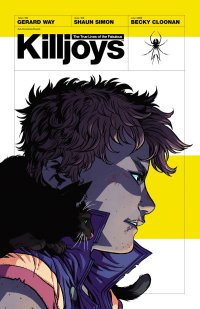
I’ve found myself re-evaluating my position on the band My Chemical Romance. Certainly I wouldn’t go so far as to call myself a fan – more a casual listener – but their dabbling with concept albums, the fact that they wear their influences on their sleeves for all to see, and the fact I can actually recognise their songs when they’re on the radio goes a long way toward me respecting what they were about, even if I still don’t own one of their albums.
Their final album, Danger Days: The True Lives of the Fabulous Killjoys, has been at the back of my mind for a while now, and not just because it’s a pop-punk rock opera set in a post-apocalyptic future California where neon-haired renegades fight an evil corporation and therefore is guaranteed to register as at least a blip on my radar; singer-lyricist Gerard Way has previous experience with comics, having written the Doom Patrol-inspired The Umbrella Academy for Dark Horse, so it came as little surprise when I started seeing The True Lives of the Fabulous Killjoys popping up on the shelves of my local comics store like some sort of hipster-seeking missile.
Picking up roughly fifteen years after the events of the album, True Lives follows album/music video messianic side-character The Girl as she scrapes by in the desert surrounding the dystopian Battery City, Better Living Industries’ tame dragon and Grant Morrison lookalike Korse*, and a blue-haired sex-droid called Blue who is trying to save her obsolete roommate called Red from being recycled. The band’s stand-in characters the Killjoys are long-dead, murdered by BLI after rescuing The Girl from their clutches, and have been replaced by a gang of equally interchangeable upstarts who reckon they have what it takes to smash the system. The Girl, meanwhile, is going through a bildungsroman of her own that involves learning to shoot ray-guns real good and taking a course in understanding vague poetic prophecies regarding her role in saving the world. Korse, previously an uncomplicated contract killer for The Man, is now a conflicted Starscream who has a secret boyfriend his boss isn’t meant to know about because… reasons. Look, it’s a Tank Girl clone with anime and Blade Runner elements – subtlety isn’t order of the day here.
The setting of the story does lend itself to some cool, if uncomplicated, visual storytelling from Becky Cloonan, doing her best attempt to capture a Jamie Hewlett-esque apocalyptic wasteland. The dissonance however comes the inclusion of elements from the music videos that don’t quite gel in the heightened reality Cloonan’s artwork allows for. For instance, the conceit that all power in Battery City (including the plastic toy laser-guns everyone uses) comes from batteries, and that the “Draculoid” and “Scarcrow” secret policemen where cheap rubber face-masks that make them mindless robots controlled by BLI, is the kind of thing you can let slide in a goofy stylised music video, but when placed alongside True Lives’ attempts to incorporate more fantastical elements like androids, the technologically advanced Battery City and giant destroyer robots, plus a slightly erratic use of framing – man, I’m pretty easy going about this stuff, but sometimes it’s just too big a crazy pill to swallow in one go. And as the fractured plot and dialogue would suggest, it’s difficult to tell where Gerard Way ends and co-writer Shaun Simon begins.
But, having said that, and with the caveat that if you really want to read a Tank Girl clone you’re better off just reading Multiple Warheads, I’ll admit that as a not-fan of the group with a passing interest in the book’s album predecessor, it didn’t outstay it’s welcome. I’m not drinking the Kool-Aid, but as books go, it’s not bad.
So there you have it – two comics you’re probably better off waiting for the trade paperback for. Next time – I find out if Warren Ellis and Kelly Sue DeConnick writing Avengers Assemble is the Ultimate Combination or a load of pish. Peace out, y’all
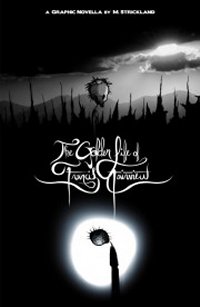 The Golden Life of Francis Fairview: Blood Series #1 (Varnson Productions, $9.99)
The Golden Life of Francis Fairview: Blood Series #1 (Varnson Productions, $9.99)
By Cat Taylor
The Golden Life of Francis Fairview tells a story set somewhere in a dystopian future where classes are divided and the scientific community is among the elite. There is also an oxygen shortage, a valuable commodity known as thineon, and the threat of a plague. Francis Fairview is the son of an elite family but he knows little about his own background or why he’s supposedly so special and sets out to meet with all the people who knew his father to find out why, what exactly his father was into, and how he can become the most powerful of all the elite class. Yes, it’s a lot to take in and if you’re like me, you’ll find yourself trying to remember all of this and understand the setting for the first half of the book.
Whether you enjoy this story or not will likely depend on your mood and how much you typically enjoy stories with a darker edge. Did I say “darker edge?” That may be an understatement. The tone of this book throughout is downright depressing in every way it can be. The lead character, Francis Fairview, is determined to solve mysteries about himself and his family but is apathetic and depressed about everything else. When his world starts falling down around him, he doesn’t even care. This is not to say Golden Life of Francis Fairview isn’t well-written and interesting but don’t expect any uplifting moments. The closest comparison I can make is to say it’s similar in tone and structure to Neil Gaimen’s Coraline or some of the stories of Shel Silverstein, but those stories are typically a little more light-hearted with a touch of positivity. So, let’s just call this a dark children’s story for adults. I can’t say I “like” this story, but it accomplishes what I suspect the writer/artist/publisher, Matthew Strickland, intended.
As if the story itself isn’t dark enough, Strickland’s art is literally and figuratively the darkest work I’ve seen in as long as I can remember. Dark though it is, what Strickland puts on the page is not like any comic book art I’ve ever seen. It’s very abstract and looks like any panel could be a standalone painting in a gallery. The images he uses to portray the characters aren’t really people but are rather symbolic approximations of each character. If I were to sum up his art with one word it would be “terrifying.” What Strickland lays out here is the stuff of nightmares and I can’t stop looking at it. I have the feeling that’s exactly what he wants.
Rating: 




Out of a Possible 5 Stars